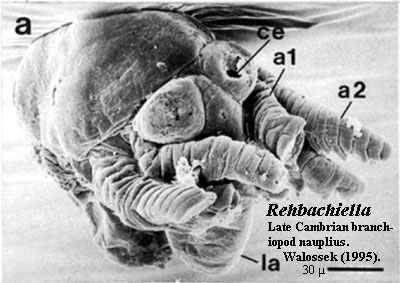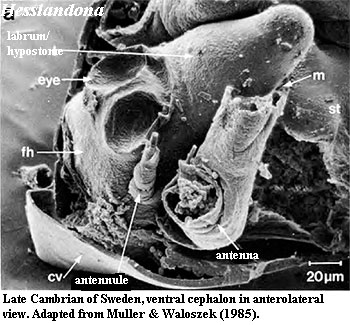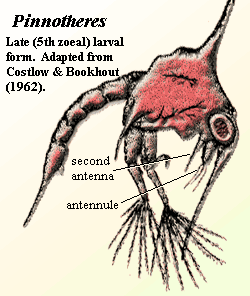
| Palaeos |  |
Crustacea |
| Arthropoda | Crustacea - 2 |
| Page Back | Unit Back | Metazoa | Dendrogram | References | Taxon Index |
| Page Next | Unit Next | Unit Home | Unit Dendrogram | Unit References | Glossary |
PROTOSTOMIA |--ARTHROPODA | |--Trilobita | `--PANCRUSTACEA | |--CRUSTACEA | | |--Pentastomida? | | `--+--Remipedia | | `--+--Cephalocarida | | `--+--Malacostraca | | `--+--Maxillopoda | | `--Branchiopoda | `--INSECTA `--LOPHOTROCHOZOA |--MOLLUSCA `--ANNELIDA |
Contents
|
 Like most crustaceans, branchiopods have
at least three eyes. In addition to the
usual paired compound eyes, crustaceans have one or more central, unpaired naupliar eyes. The
naupliar eye takes its name from the
nauplius, the characteristic larval
form of
crustaceans (see image above). The nauplius is essentially a swimming head bearing three pairs of appendages which will
later become the antennules, antennae and
mandibles (anterior mouth parts.)
This form of development -- starting with a free-floating head and growing
backwards in stages -- has inspired considerable deep thought about animal
development and evolution. See, for example,
Meinhardt (2002).
Like most crustaceans, branchiopods have
at least three eyes. In addition to the
usual paired compound eyes, crustaceans have one or more central, unpaired naupliar eyes. The
naupliar eye takes its name from the
nauplius, the characteristic larval
form of
crustaceans (see image above). The nauplius is essentially a swimming head bearing three pairs of appendages which will
later become the antennules, antennae and
mandibles (anterior mouth parts.)
This form of development -- starting with a free-floating head and growing
backwards in stages -- has inspired considerable deep thought about animal
development and evolution. See, for example,
Meinhardt (2002).
While we're on the subject, we should mention that some crustaceans, particularly Malacostraca, pass through the naupliar stage in the egg. Later larval stages (with functional limbs on the thorax/pereon) are often referred to as zoeae. Frequently a larval crustacean will pass through several zoeal forms before graduating to juvenile and adult stages. Terms for last larval and for post-larval juvenile stages tend to be specific to particular taxa, and it would be pointless to cover them here. However, it is worth knowing that development tends to be more plastic in crustaceans than in most animals. That is, some larval stages may be skipped or prolonged, depending on environmental conditions. For a recent review, see Anger (2006).
But we were supposed to be discussing naupliar eyes, and we will do so.
The naupliar eye is a set of simple photosensitive organs, of a sort that may
well have been present in the first Bilateria. In many branchiopods, the naupliar eye is retained into adulthood
[3].
 Crustacea may have an even or odd number
of naupliar eyes. The primitive number
for crustaceans may be
three, innervaed by a median ocellar nerve center. This may become paired in
some crustaceans.
Harzsch (2006). The naupliar eye develops some fairly interesting bells and whistles
in some species. For example, in copepods, the median eye is not only
quite large, but it develops a
tepetum, an
internal reflective layer, such as the layer which makes the eyes of cats appear
to glow in the dark.
Martin & Davis
(2001). However, even the tapetum may be primitive character.
Giribet et al.
(2002). Some of the Orsten stem-crustaceans, or perhaps stem-arthropods,
apparently bear the simple eyes on the hypostome, a structure we will discuss
later. Müller
& Waloszek (1985).
Crustacea may have an even or odd number
of naupliar eyes. The primitive number
for crustaceans may be
three, innervaed by a median ocellar nerve center. This may become paired in
some crustaceans.
Harzsch (2006). The naupliar eye develops some fairly interesting bells and whistles
in some species. For example, in copepods, the median eye is not only
quite large, but it develops a
tepetum, an
internal reflective layer, such as the layer which makes the eyes of cats appear
to glow in the dark.
Martin & Davis
(2001). However, even the tapetum may be primitive character.
Giribet et al.
(2002). Some of the Orsten stem-crustaceans, or perhaps stem-arthropods,
apparently bear the simple eyes on the hypostome, a structure we will discuss
later. Müller
& Waloszek (1985).
We will not engage in the usual discussion of compound eye structure because we think it's boring. However, the crustacean compound eye does have two ancillary points of interest. First, carcinologists have had recurring suspicions that the eyestalk might be the missing appendage of the acron.
There may be yet a third sort of photoreceptive organ, the so-called "frontal organ." Harzsch (2006). However, we have little information on these systems; and it appears that there is not much information to be had.
 The mouth is a ventral slit, as in the great majority of crustaceans.
Brachiopods have two pairs of maxillae in addition to the mandibles.
Often, crustaceans exapt one or more pairs of thoracic limbs to become
mouth parts (maxillipeds); but this does not occur in branchiopods.
Averof & Patel
(1997).
The mouth is a ventral slit, as in the great majority of crustaceans.
Brachiopods have two pairs of maxillae in addition to the mandibles.
Often, crustaceans exapt one or more pairs of thoracic limbs to become
mouth parts (maxillipeds); but this does not occur in branchiopods.
Averof & Patel
(1997).
The leaf-like (phyllopodous) thoracic limbs of Artemia are perhaps typical of branchiopods. Some crustaceans have two types of trunk appendages.
All but the smallest crustaceans have a heart. Branchiopods generally have no other circulatory system, and the heart simply circulates fluid in an open hemocoel. Branchiopods, and several other crustacean groups, have an iron-heme oxygen carrier protein referred to as hemoglobin and distantly related to the vertebrate hemoglobin. However, branchiopods do not have a separate respiratory system and rely on diffusion for gas exchange. ATW
| Page Back | Page Top | Unit Home | Page Next |